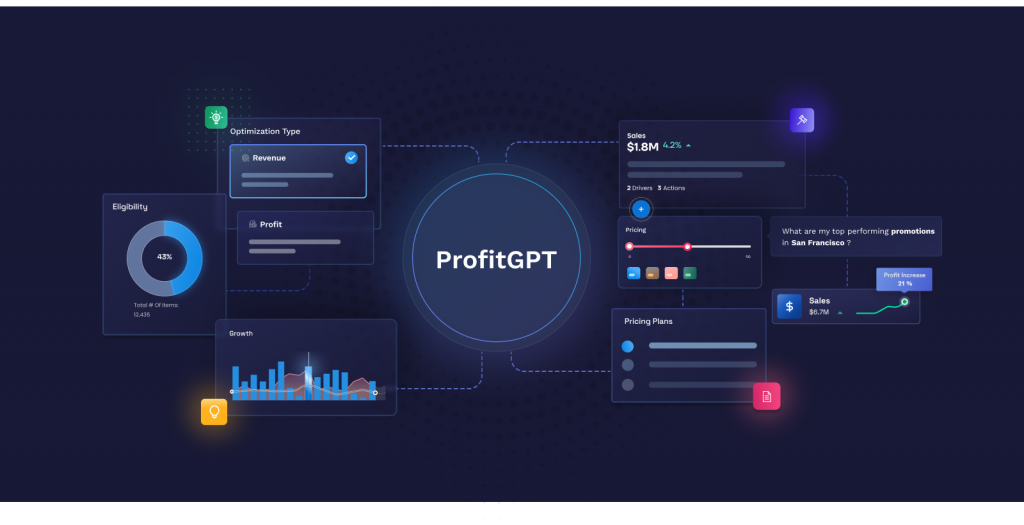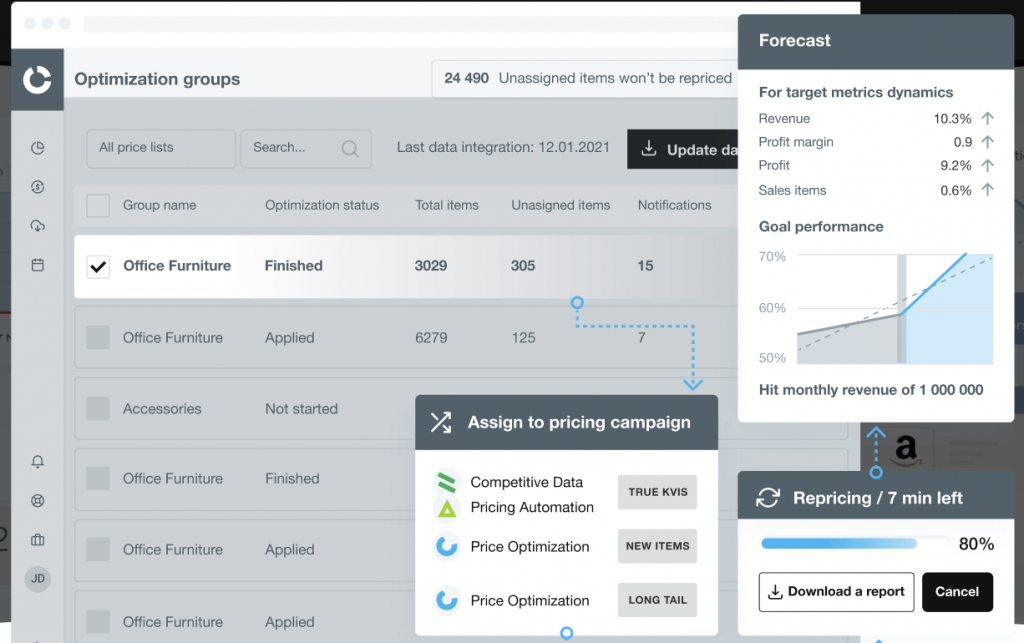The Best Pricing Tools in a Dynamic Pricing Environment
The Best Pricing Tools in a Dynamic Pricing Environment
In response to continued price volatility and supply instability around the globe, more retailers and ecommerce companies are adopting dynamic pricing. However, manually adjusting prices with spreadsheet analysis and traditional analytics has become unrealistic for ecommerce businesses with multiple product catalogs. To implement data-backed dynamic pricing, an increasing number of businesses are turning to pricing tools.
In this guide, you’ll learn what a pricing tool is and explore some of the top products on the market.
Key Takeaways
- Dynamic pricing is on the rise in retail and ecommerce.
- Businesses need the automation and monitoring capabilities of pricing tools to implement dynamic pricing effectively.
- Businesses in the market for a pricing tool have many options, but Hypersonix provides the broadest range of capabilities for dynamic pricing management with rapid ROI.
What Is a Pricing Tool?
A pricing tool is a customizable application businesses use to set prices for products and services. It’s especially useful for businesses that often change prices – such as ecommerce stores and on-demand service providers. Pricing tools enable these businesses to make faster price adjustments and price strategy implementation than is possible with manual price setting.
Pricing tools are customizable in the sense that businesses can use them to implement different kinds of pricing strategies – such as competitor pricing, profit optimization, or market penetration pricing – and monitor different price-related metrics.
Common features pricing tool platforms offer include:
- Price optimization: Simulates a range of price adjustments over time to calculate optimal prices.
- Pricing automation: Automatically adjusts prices for different products and services based on selected price strategy and within set limits.
- Competitor price tracking: Monitors prices currently available from selected competitors.
- Systems integration: Integrates with a business’s existing IT stack so that pricing data populates in other systems, such as customer relationship management (CRM) software and enterprise resource planning (ERP) platforms.
Top Pricing Tools Currently on the Market
Developments in AI and machine learning combined with increased demand for scalable price management solutions have brought more pricing tools for dynamic pricing to market in recent years. Here are the top six tools businesses looking to implement dynamic pricing should consider.
1. Hypersonix
Hypersonix ProfitGPT is an AI-driven pricing and inventory optimization platform. Applying minimally supervised machine learning algorithms to historical data and a wide range of external conditions, Hypersonix delivers actionable recommendations based on transparent probability assessments and exhaustive simulation data.
Features
For pricing, Hypersonix excels in several categories:
- Proactive and timely monitoring: Focuses on identifying risks and opportunities in pricing data by constantly monitoring competitor pricing, market conditions, and other variables such as weather, geopolitical events, and regional logistics.
- Predictive and prescriptive recommendations: Recommends specific actions tied to transparent, data-backed analysis and simulation and generates forecasts for categories such as profitability, inventory, cash management, and promotional events.
- Anomaly and pattern detection: Monitors internal and external data sources for potentially significant anomalies and outliers.

Integrations
Hypersonix integrates natively with major ecommerce platforms, including:
- Amazon
- Ebay
- Walmart
- Netsuite
- Lazada
- Channel Advisor
- Shopify
- Magento
- Feedonomics
- BigCommerce
2. Competera
Competera is a software-as-a-service (SaaS) platform that offers price optimization and automation services. The platform has AI-enabled capabilities for initial price benchmarking, cascading price reduction for clearing stock, and price recommendations based on demand elasticity.
Features
Competera’s self-learning competitive data monitoring delivers a matching quality of 98% and adapts well at scale. Competera’s monitorable categories for price automation include:
- Competitor pricing
- Inflation
- Seasonality
- Inventory levels
- Elasticity
- Historical purchasing data

Integrations
Competera supports integration with:
- Google Cloud
- Adobe Commerce
- Amazon EC2
- Oracle CRM on Demand
3. Acctivate
Acctivate’s pricing and inventory management software serves small-to-mid-sized manufacturers, distributors, and online retailers who use QuickBooks. Acctivate is essentially an extension of QuickBooks, and users can purchase the functionalities they want individually.
Features
For pricing, Acctivate tracks historical data on sales, shipping and customs costs, risk, and overhead. Users can generate reports for trend analysis, margin analysis, and discount performance.
Integrations
Acctivate runs on QuickBooks and is only suitable for companies that use QuickBooks for accounting and point-of-sale.

4. Iris Pricing Solutions
Iris Pricing Solutions is a relatively new pricing tool for strategy implementation and analytics focused on use in retail, ecommerce, manufacturing, distribution services, and healthcare.
Features
Iris’ Pricing Insights Generator offers four primary pricing features:
- Price value map: Assesses customer perception of brands and their industry positioning.
- Pricing waterfall: Quantifies true net prices, price leakage between list and pocket prices, and capturable lost revenue.
- Price dispersion analysis: Provides data visualization for price/volume relationships, profit leaks, and statistical outliers.
- Pricing power assessment tool: Analyzes customer purchase motives, high and low-price markets, and customer segmentation data.
Integrations
5. Sniffie
For retailers and ecommerce companies in the European Union, Sniffie is an option for pricing tool SaaS. The platform has competitor price monitoring capabilities and AI-generated recommendations.
Features
In Sniffie’s product dashboard, users can apply pricing rules to all products, filtered selections, or products by category. Sniffie integrates out-of-the-box with several popular CRMs and ERPs and offers a 14-day trial version. Sniffie is not currently available in North America.
Integrations
Sniffie supports:
- Shopify
- Magento
- WooCommerce
- Microsoft Dynamics
6. PROS
PROS is a price optimization and management tool for B2B users. Pricing teams can use PROS to monitor competitor pricing and populate downstream systems such as CRMs, ERPs, and ecommerce platforms with automated pricing recommendations.
Features
The platform’s areas of focus are:
- Omnichannel price management: Offers a range of integrations for dynamic pricing.
- Customer-specific price optimization: Can generate personalized pricing recommendations for specific clients based on purchase history, account size, and logistical conditions.
- Pricing governance and transparency: Applies customizable business rules and allows users to see which rules apply in different pricing recommendations.
- Real-time pricing recommendations: Can implement pricing recommendations automatically in integrated systems.
Integrations
PROS works natively with several CRMs and ERPs:
- Microsoft Dynamics
- Salesforce
- Oracle Magento
- DocuSign
Drive Profitability in Your Ecommerce Business with Hypersonix ProfitGPT
Hypersonix ProfitGPT integrates out-of-the-box with the ecommerce and ERP platforms you already use to deep dive your profit, inventory, and cost data for immediate actionable insights. With unrivaled, proactive monitoring for risks and opportunities, Hypersonix is at the forefront of price and profitability optimization, offering innovative solutions for businesses.
Request a demo of Hypersonix Profit OS today to get started.





